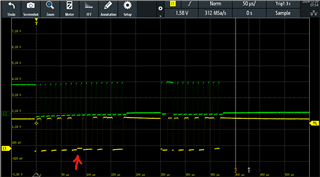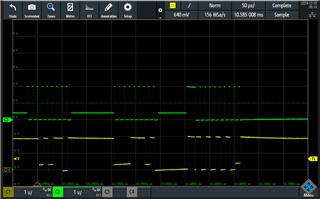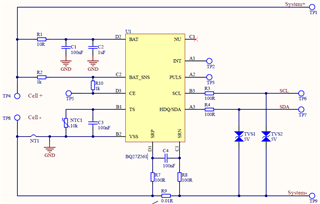Tool/software:
Dear TI community,
We are working on BQ27Z561-R2 battery pack project. Battery pack with gauge inside and that solution is connected in to the system. After testing prototype in greater quantities we noticed that after some random time communication with gauge fails. We are now in the process of hunting down the problem. After probing I2C line we noticed strange behavior. When communicating with other system I2C devices that phenomenon is not present and I2C waveform looks normal. STM32 communication with BQ27Z561-R2 gauge looks like shown in screen grab below.
SDA line sometimes does not reach 0V


Tried to use I2C line buffer FXMA2102 but that just amplifies the problem and communication failure occurs more often. Screen with FXMA2102 used, signal on the gauge side of the buffer:

So we have tried two different scenarios:
1. When I2C buffer is not used, battery pack gauge always see I2C line and its pull-up voltage. Standard I2C situation.
2. When I2C buffer is introduced we gain additional feature to disable I2C line going to the battery pack and we use that. After gauge read out we disable buffer. SDA and SCL both become low. We then activate I2C line every ~5sec to update status from battery . I'm not sure if that is important so I decided to mention.
In both scenarios outcome is the same. Communication with gouge fails after some random time and we are not able to read the status. We persistently try to read the status few times. Its not only one failed communication attempt.
Pack side gauge schematic is very basic and mimics the evaluation board

Regarding the related question I tagged to my question - we have checked and seems our STM32 uses Open Drain topology so its not the case as in nRF5340 that related question was referring to. Hope you will have some hints on what to do or check next.
Wish you happy upcoming holidays!
Best regards, Aivaras



